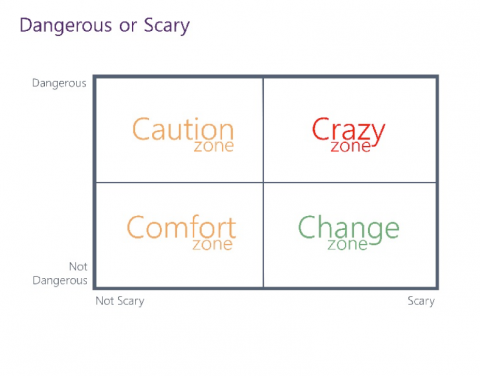In Transformation with a Capital T (McKinsey & Co) the article begins with the statement: “Companies must be prepared to tear themselves away from routine thinking and behaviour.”
This is a provocative way to open an article, but it’s an idea I can’t help agreeing with. What we like to ask is how and why. But first let’s focus on what:
What is routine thinking?
Routine thinking is based on regular procedures and is often set within the parameters of expected norms. There is a safety in routine thinking: if something has worked in the past, allow it to work in the future too.
The problem here comes in the question of progression. What can be enhanced when we are confined to our way, or our organisation’s way, of thinking.
How do we tear ourselves away from routine thinking?
Now it’s all too easy to create debate. Poke a few holes in a theory and see if it is robust enough to pad out the gaps. If we want to move away from routine thinking, what would be the exact opposite of the routine; how feasible would that be to do?
To carry out this line of questioning through each procedure you have would be impossibly long-winded and ultimately demotivating for your team. So, instead of interrogating a new way of thinking at a process-level, the mindset has to be adopted at an organizational, or team, level. If you are to unlock new thinking and new behaviours in your people, you need to create an environment in which your people can thrive and truly think and behave differently.
Why should we do this?
Simple answer: for efficiency and effectiveness.
Detailed answer: In their Case Study, Project Aristotle, Google sought the perfect formula for creating effective teams. Routine thinking might suggest that effective teams are the result of effective management and leadership. But the results of Project Aristotle showed something else. In their research, over 180 teams were studied but no patterns emerged. They extended their research to review the traditions, behavioural standards and unwritten rules that govern how the team functions.
As no two teams appeared alike, Project Aristotle uncovered that a team’s norms are unique to that particular team. Something has been established within a team to make it different from themselves. I believe the key to norms is through an emotional connection, and this is echoed in Project Aristotle’s findings that psychological safety is an essential component of an effective team. Teams were found to perform well when certain conditions exist; interpersonal trust, mutual respect and comfortable being themselves.
Key evidence is in the way they allowed others to fail safely, there was respect for divergent opinions, there was freedom to question the choices of others in a supportive way, and they never undermined the trust. This meant that they could do away with routine thinking and rely on the trust of their colleagues.
My primary takeaway from the Google research is the need for psychological safety. Charles Duhigg explores this further in his enlightening book Smart Faster Better.
Can this be more than Silicon-Valley Fantasy?
When I reflect on my own experience, I have only ever felt psychological safety twice in my 30-year career, and they happened simultaneously.
I was part of two teams. I had my own team and was a member of a senior team. We outperformed all expectations this particular year. Morale within my team was immense and that gave us a feeling of safety to encourage our colleagues to continue outperforming expectations.. We were unaware, however, of the merger talks happening at the same time. After the merger was announced, I spoke to a board member about the decision. They spoke ruefully of our success, that “if we knew then how you were going to perform this year, we would never have agreed to merge”.
The psychological safety felt quickly turned illusory, and I wonder now how I would’ve felt if that year we plodded along in our routine thinking; would we have been more accepting of the merger? Was the news devastating in contrast to the high team spirit?
As leaders, there is an interesting choice …
…do you:
- Break the mould and create an environment where people can take a chance, fail safely, learn then grow on the back of it?
- Accept the safety in routine thinking, play it safe but miss out on potential innovation?
Do you know leaders who sit somewhere between the two? Those who say that they are up for the challenge but revert to type at the first signs of trouble?
It is difficult to embed a different way of thinking to your working life. But to establish an environment of psychological safety offers Googleable advantage.
I accept this is simplistic but business today runs at such a pace. You only have to look at the media to see failure in businesses, large and small. Leaders make commitments to stakeholders on best information available that means results are then demanded. We look to blame others for failures which are then punished and, worse, the opportunity to learn is missed. When you add to this personal agenda and vested interest is it any wonder that performance and people suffer? However well intentioned leaders might be, when it all hits the fan, they revert to type to get stuff done. It is this behaviour that undermines psychological safety and essentially leads to any business running with the handbreak on. People hold back.
When faced with the pressures of today, it takes a brave (or clever) leader to tear themselves away from routine thinking and behaviour.
If you’d like to explore psychological safety in your organisation let’s have a conversation. Email me at ricky.muddimer@thinkingfocus.com and we’ll arrange a time to chat.






